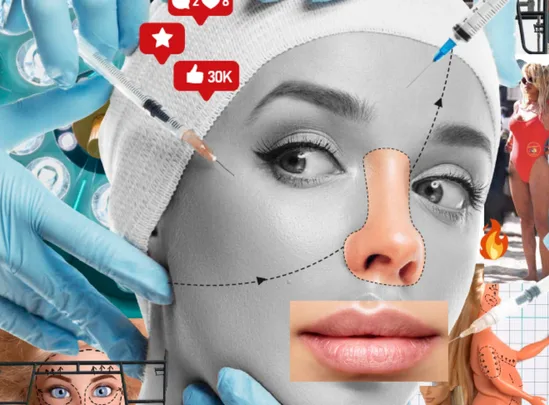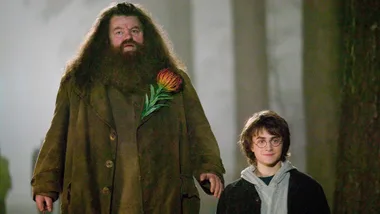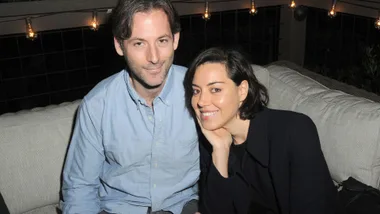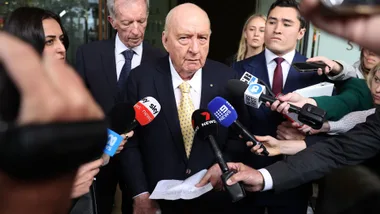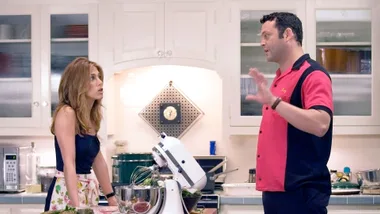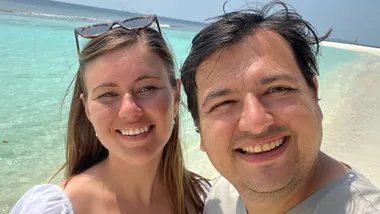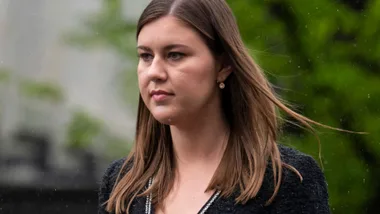Breast implants, lip fillers, nose jobs, buccal fat removal, Brazilian butt lifts – we’re a nation obsessed with our looks. But many believe such risky, painful procedures in the name of fashion may be hiding deeper questions about our impossible beauty standards. Here, marie claire Australia investigates the concerning rise in trendy cosmetic surgeries.
Skye Doherty was sitting in the chair at her cosmetic surgeon’s practice, gritting her teeth through the intensely painful experience of having her lip filler dissolved, and thinking, “This is not who I am. How did I end up here?”
The veterinarian nurse had never been one to follow trends. She bought clothes that suited her, rather than what the It-girls were wearing. She wasn’t on Twitter or Instagram and she couldn’t tell one Kardashian from the next. That’s why she was surprised when, in 2016, she found herself desperately wanting lip-filler, inspired by singer-songwriter Lana Del Rey.
“I just thought she always looked so sultry and sexy,” the 31-year-old tells marie claire. “And at the time lips were the thing everyone was getting. I wanted to have juicy lips too.” The procedure was painful but, as the saying goes, beauty is pain, and Skye was eager to see the results. Her initial reaction was shock. She hadn’t expected them to be so … big. “They’ll go down,” the aesthetician assured her. “They’re extra swollen now.”
The surgeon was right, but weeks later Skye still couldn’t get used to her plumped pout. “I realised it wasn’t for me,” she says. “I felt self-conscious about getting work done and didn’t want to admit it to friends and family but anyone with a pair of eyes could see I looked different. I knew I looked like all the other girls who were getting their lips done and I didn’t like that.”
Eventually Skye decided to get them dissolved and even now cringes when she reflects on her lip-filler era. “I don’t object to cosmetic surgery or enhancements but I’d think long and hard before ever again jumping on a surgical procedure that happened to be the current beauty standard. I look back at photos from that time period and think, ‘I never needed that.’”
Skye isn’t alone. Syndi Carrick-Ryan had been intensely insecure for as long as she could remember. The 23-year-old never believed she was good enough for anything or anyone. She hated everything about herself and yearned to look like the women she saw in magazines and on television. The intensity of her self-loathing culminated in her biggest grievance: her breasts.
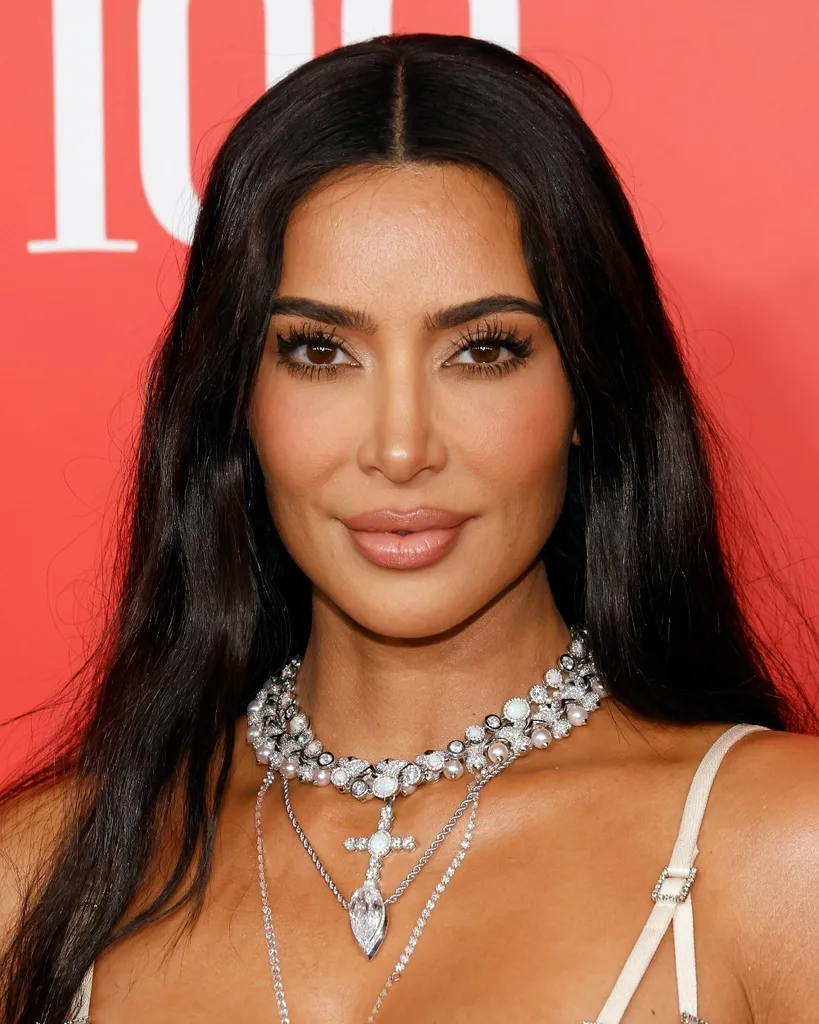
Pondering a “boob job”, her initial consultation with a surgeon revealed she had a medical condition known as tuberous breasts, which is when breasts fail to develop normally. In addition, she was diagnosed with no breast tissue and four hernias, two in each breast. Syndi was given two options: remove the hernias and be left with just nipple, or remove the hernias and get breast implants. Driven by insecurity and desperation, and with breast augmentation a popular cosmetic trend, she chose the implants.
That was 17 years ago. Today, Syndi is a 39-year-old wellbeing facilitator in the Yarra Valley, and in February she had her implants removed due to breast implant illness (BII).
Since her explant surgery, Syndi has spent a lot of time reflecting on her self-worth. “My advice to anyone else is to evaluate why you are getting breast implants and the purpose they are going to serve you emotionally,” she says. “Sure, we all have things that we would like to change about ourselves but does that need for change come from a place of ‘I am not enough’ or does it come from a place of ‘I am enough’? The answer will take you down two very different paths.”
Whichever path you take, one thing is undisputed: it is every person’s right to choose what they would like to do with their bodies, whether it’s injecting fillers, getting breast implants or removing buccal fat from cheeks. Many people are very happy with their cosmetic procedures and don’t suffer after-effects. But with plastic surgery reversals now a more accessible option, it’s imperative we take a closer look at the reasons for cosmetic surgery in the first place. What drives us to want to change our appearance? And, like Skye and Syndi, can altering our bodies to suit beauty trends do more harm than good?
According to the Australasian College of Cosmetic Surgery and Medicine, Australians spend a combined $1 billion each year on cosmetic treatments – including waxing and nail appointments. But there are also half a million cosmetic surgeries performed here every year. Worldwide, the most common cosmetic surgery is breast augmentation, followed by liposuction, tummy tucks and eyelid surgery. Rhinoplasties and butt lifts also feature highly on the list.
It may seem as though we are more obsessed with how we look than ever before, but beauty trends have come and gone for tens of thousands of years. More recently, the corset made its appearance in the 1500s as women sought to cinch their waist for a more “womanly” figure. In the flapper years of the 1920s, bodies that were straight and slim were prized above all else.
In the ’50s and ’60s, everyone wanted Marilyn Monroe curves and lips. In the ’90s, Kate Moss’ “heroin chic” body was all the rage. In the noughties, it was Jennifer Lopez’s butt. Then came the Kardashian/Jenner era of big lips, flat tummies and high, perky butts. These days, angular faces with hollowed cheeks (à la model Bella Hadid) are the talk of the town. The pendulum swings back and forth.
With the advent of social media and the rise of celebrity worship, coupled with advancements in surgical intervention, cosmetic surgery on our bodies and faces is now more normalised than ever.
“As humans we are so critical of ourselves and every perceived flaw,” says cosmetic nurse, nutritionist and naturopath Madeline Calfas. “For every ‘flaw’, there is someone out there looking for a way to fix it. Celebrities have the means and access to a lot of these emerging trends. As we tend to hold celebrities up on a pedestal, it is only natural that we like to emulate them, or to at least experience what we perceive to be a little bit of their life. If it’s good enough for them, surely it must be good enough for us?”
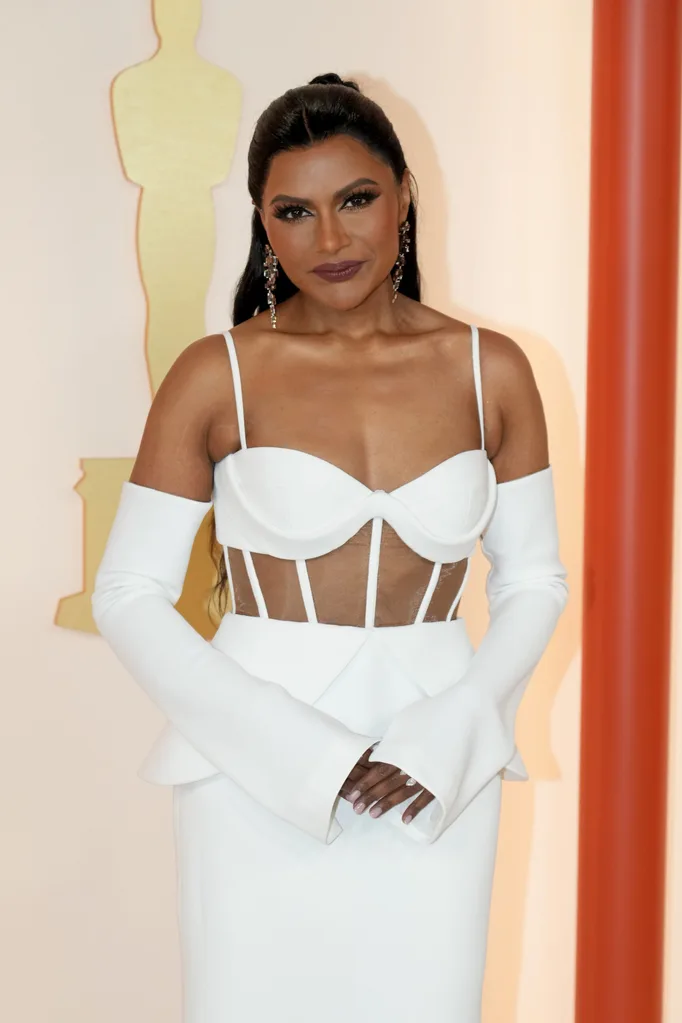
Celebrity worship can be dangerous, however. Director of BodyMatters Australasia and psychologist Sarah McMahon says it has been associated with depression, anxiety, disordered eating and body image issues. “Celebrity worship reduces cognitive dissonance, which is the one psychological phenomenon that has been demonstrated to be protective against body image concerns.”
Heightening cognitive dissonance “involves increasing our critical thinking about our own and other people’s appearances, but also reconnecting with our values and behaving in accordance with them.”
McMahon says those who are unhappy with surgical outcomes believe it has either not given them the desired physical outcome, or it has – yet they are still discontent. “Research clearly documents that when people have pre-existing body image concerns, particularly body dysmorphia, they will be poor candidates for surgery,” she says.
“They will typically be discontent with their surgical outcomes, and/ or their body image concerns will switch to other body parts. Ultimately, a psychological problem will never be fixed by a physical intervention.”
Ironically, it is celebrities themselves who have revealed their own unhappiness with what they’ve had done to their faces and bodies. Reality TV star Blac Chyna said in March this year she’d had breast implants and facial fillers removed. She has also removed her silicone butt implants, saying, “So I just want all the ladies out there to know, do not get silicone shots because you can get sick, you can die, have complications and all this other crazy stuff.” A few years ago, Actor Courteney Cox said she regretted using Botox and fillers and has had all her injectables dissolved.
Model Linda Evangelista claimed CoolSculpting, a fat-melting procedure, left her permanently disfigured due to an adverse reaction. She revealed she suffered from severe depression and had retreated from the world. She sued the company for $US50 million and the case was settled in 2022.
Designer and former pop star Victoria Beckham, in a letter to her 18-year-old self, revealed she had breast implants in the noughties, something she had long denied. “I should probably say don’t mess with your boobs,” she wrote. “All those years I denied it – stupid. A sign of insecurity. Just celebrate what you’ve got.” Business mogul Kylie Jenner confessed to using too much filler at one point, and had to dissolve it to obtain more “natural lips”. Model Bella Hadid had a nose job at age 14, but last year said, “I wished I had kept the nose of my ancestors. I think I would have grown into it.”
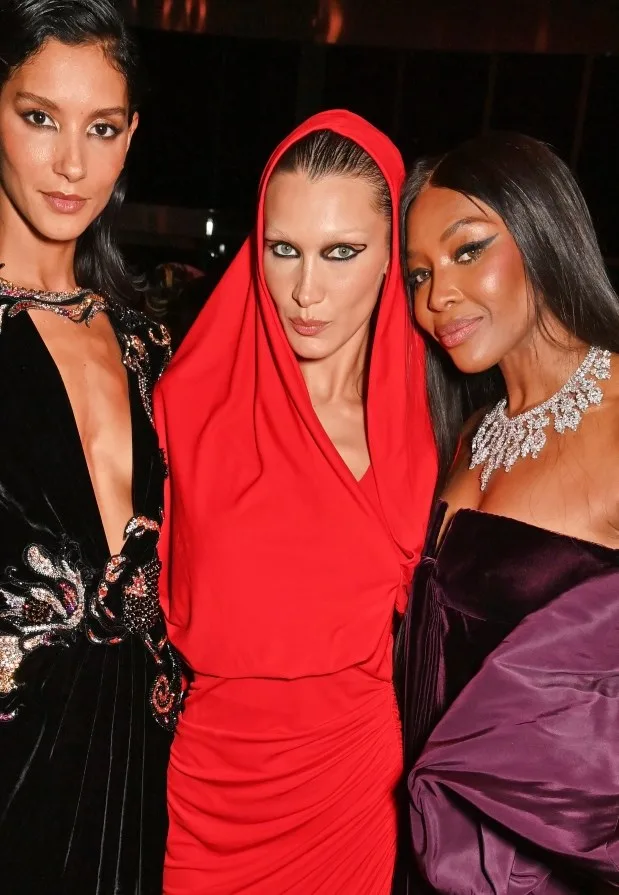
The list goes on: Britney Spears, Anna Faris, Jamie Lee Curtis, Melanie Griffith, Ashley Tisdale, Heidi Montag, Chrissy Teigen, Gwyneth Paltrow, Gisele Bündchen, Cameron Diaz and Kourtney Kardashian are just a few of the other celebrities who have regretted – or reversed – cosmetic procedures such as breast implants and fillers. Closer to home, Bachelorette alum Ali Oetjen and model Rachael Finch have revealed they removed their breast implants after realising they’d had the surgery for the wrong reasons.
“One of the biggest issues when it comes to celebrities is that many people – doctors and specialists included – don’t know how to say no to a celebrity [so] they may end up having procedures not necessarily suitable for them, or [that] have been overdone,” says Calfas. “It wasn’t until Courtney Cox realised that she had gone too far and was no longer looking like herself that she began to regret her choices. The same can be said for any patient who feels they may have gone too far or gotten a little bit carried away.”
Another reason for regret is ongoing pain, disfigurement or adverse reaction. Last year Australian TikToker Jessie Carr documented what happened after she underwent the popular “fox eye” surgery, which uses dissolvable threads to lift and elongate the eye and raise the brow tail. She not only popped a blood vessel during the procedure but her face became swollen afterwards and raised bumps formed at her temples.
In the end, Jessie had to reverse the eye lift by dissolving the threads. “I’ve been through a lot with my fox eye threads and it’s definitely not worth it. Definitely don’t recommend it,” she said on her TikTok video, which has racked up millions of views.
Yet another reason for regret or reversal is because the patient didn’t quite understand the treatment they were having and what it was supposed to do. An ongoing investigation by The Sydney Morning Herald, The Age and 60 Minutes has found there are “cosmetic cowboys” who are often unqualified to perform surgeries and who don’t provide adequate information or after-care.
Specialist plastic surgeon Dr David Morgan sees a system flawed at its core. “When all the regulatory frameworks were set up, no-one really envisaged that people would go ahead and do non-medically necessary surgery, let alone have them be performed by people who are not accredited as surgeons or in facilities that are not regulated as health facilities. So basically [it’s happening] under everybody’s noses but not under anybody’s watch,” says Morgan, who is also the vice-president of the Australian Society of Plastic Surgeons.
“Even now, anyone who graduates from medical school in this country can call themselves a surgeon. The health ministers have recently decided they want to change that but it has yet to go through the Queensland Parliament, which is the home base of this legislation.”
Ultimately, cosmetic surgery is still surgery, and there is an element of risk. Some procedures, such as buccal fat removal, are permanent. “The big issue with buccal fat and anything that removes volume is that we all naturally lose volume as we age,” says Morgan. “By having buccal fat removal done as a younger person, you are effectively bringing forward that moment in time when you start to look old in the mirror.”
Calfas says other risks depend on what you are having done. Surgery such as implants and Brazilian butt lifts (BBL) will generally carry higher risks – up to and including death – but non-invasive procedures have their own downsides, such as bleeding, scarring and infection.
For 36-year-old South Australian Bianca Hicks, nothing is worth the risk. Like Syndi, she had breast implants as a young woman, developed BII and recently had them removed. “If I were to tell my younger self about these issues, I probably wouldn’t have believed it,” she says. “I was so insecure and self-conscious of how my chest looked that I saw getting implants as my only way of being accepted. So I wish that I could say, ‘Don’t do it, it’s not worth losing years of your life,’ but I know there will be women out there who won’t want to hear the warnings.
“At the end of the day, life is about what you can offer to the world,” says Bianca. “It’s about how good you make people feel and what positive change you can make, not the size of your breasts.”
This article originally appeared in the June issue of marie claire Australia.
